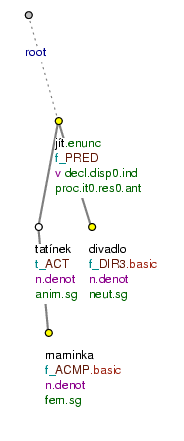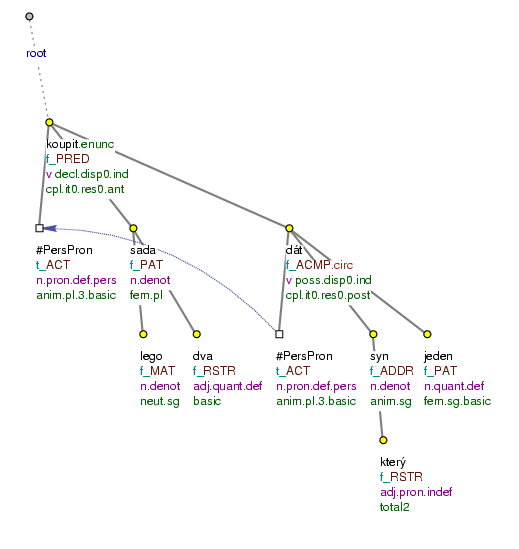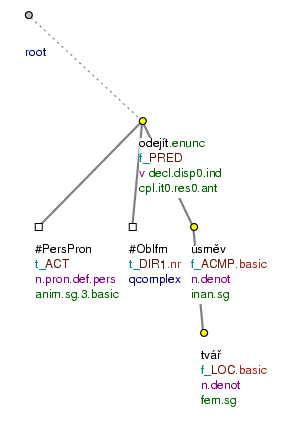- Definition of the
ACMPfunctor -
The
ACMPfunctor (accompaniment) is a functor for such an adjunct which expresses manner by specifying a circumstance (an object, person, event) that accompanies (or fails to accompany) the event or entity modified by the adjunct.
Subfunctors. The ACMP functor is further specified by subfunctors. See also Section 13.1.1, "Subfunctors with the ACMP functor".
Modifying nouns and verbs. Adjuncts with the ACMP functor modify both nouns and verbs. If the adjunct with the ACMP functor modifies a noun, the accompaniment meaning is clearer; if it modifies a verb, this meaning is weaker and the adjunct expresses rather a circumstance accompanying the main event.
Modifying nouns. Modifications with the ACMP functor modify nouns especially in the following cases:
-
two (or more) people or objects are together (coordination in a hypotactic form).
Examples:
Tatínek s maminkou.
ACMPšli do divadla. (=lit. Father with Mother went to theater) Fig. 7.29babička bez dědečka.
ACMP(=Grandma without Grandpa)všechno bez toho.
ACMPnejdůležitějšího (=everything without the most important thing)válečná plavidla včetně bojových letadel.
ACMPa bitevních vrtulníků.ACMP(=warships including air force)NB! These cases are not analyzed as paratactic structures. The choice of the form is respected (just like with false dependent clauses; see Section 5.4, "False dependent clauses"). The second member (denoting the accompanying entity) is dependent on the first one and is assigned the
ACMPfunctor.!!! The reason for adopting this solution was the fact that sometimes it is difficult to distinguish cases of hypotactic coordination from real accompaniment (e.g. král se svým sluhou (=the king with his servant)).
-
a person and object are viewed as belonging together.
Examples:
Do tramvaje nastoupila žena s květinou.
ACMP(=A woman with a flower got on the tram)muž bez klobouku.
ACMP(=a man without a hat)
Modifying verbs. Modifications with the ACMP functor modify verbs in the following cases:
-
expressing a circumstance accompanying the main event.
Examples:
Odešel s úsměvem.
ACMPna tváři. (=He left with a smile on his face) Fig. 7.30Vrátil se bez nálady.
ACMP(=He returned in a bad mood; lit. without mood)Udělali to s úžasem.
ACMP(=They did it in (lit. with) astonishment)This type also includes cases of expressing a vague circumstance by a dependent clause introduced by s tím, že (=lit. with that that) or bez toho, aby (=lit. without that that). The effective root node of the dependent clause is assigned the
ACMPfunctor since the connective does not signal clearly enough the semantic relation between the clauses (like purpose, condition etc.). This vaguenes is expressed by theACMPfunctor.Examples:
Koupili dvě sady lega s tím, že dají.
ACMPkaždému synovi jednu. (=They bought two sets of lego, planning to give one to each of their sons; lit. with that that they give...) Fig. 7.31Vyšetřovatel nakonec případ ukončil s tím, že oheň zapříčinila.
ACMPnedbalost pracovníků stavební firmy. (=The investigator closed the case with the conclusion that (lit. with that that) the fire was caused by the negligence of the workers)Požádal o příspěvky s tím, že dárci musí uvést.
ACMPi údaje o sobě. (=He asked for the financial contribution knowing that (lit. with that that) he had to provide personal details)Takové je stanovisko fotbalového klubu s tím, že na úkol přebudovat.
ACMPmužstvo zbývá ještě půl roku. (=Such is the standpoint of the football club, there being the fact that (lit. with that that) there is still half a year to rebuild the team)Oznámilo to ministerstvo zahraničí s tím, že nejprve budou stažena.
ACMPválečná plavidla včetně bojových letadel a bitevních vrtulníků. (=The Foreign Ministry announced that and said that (lit. with that that) the warships as well as the air force will be withdrawn)Tenis může být podívanou i bez toho, aby po kurtě chodily.
ACMPpolonahé děvy s tabulemi oznamujícími skóre. (=Tennis can be a good show even without (lit. without that that) half-naked girls walking on the tennis court...)NB! The prepositional phrases s tím and bez toho in s tím, že and bez toho, aby contain supporting expressions. See also Section 5.3.1, "Correlative pairs with the supporting expression "ten"".
NB! If the ACMP modification is in a distance relation with a noun, it also modifies the event itself (e.g. Tatínek šel do divadla s maminkou (=lit. Dad went to theater with Mum)). In such cases, the ACMP adjunct depends on the verb (and it is a case of vague circumstance). See also Section 11.1.1, "Ambiguous relations with adjuncts expressed by prepositional phrases".
Forms. The basic forms of the ACMP modification are:
-
prepositional phrase.
The most common forms:
bez+2 Pracuje bez brýlí. (=He works without glasses) ruku v ruce s+7 Podniká ruku v ruce s falešností. (=He runs his business dishonestly; lit. hand in hand with falsity) s+7 Chodí s holí. (=He walks with a stick) spolu s+7 Spolu s tebou to zvládnu. (=I can handle it with you) společně s+7 Učitelé společně s žáky odjeli na kurz. (=The teachers (together) with the pupils left for the course) v čele s+7 skupina deseti odborníků v čele s ředitelem (=a group of ten professionals with the manager in the lead) včetně+2 školní pomůcky včetně sešitů (=shool aids, including jotters) v souvislosti s+7 V souvislosti s růstem mezd se zvýšila poptávka. (=In connection to the wage rise, the demand increased) ve spojení s+7 Udělal to ve spojení s Pavlem. (=He did it together with Pavel) zároveň s+7 Vláda zároveň s růstem počítá i s poklesem. (=The government counts on rise as well as fall) -
dependent clause.
The most common forms:
bez toho - aby Dodavatelé mají povinnost vykupovat vratné obaly bez toho, aby je vázali na nákup zboží. (=The suppliers are obliged to buy back returnable containers without making it dependent on...) s tím - že Koupili dvě sady lega s tím, že dají každému synovi jednu. (=They bought two sets of lego, planning to give one to each of their sons; lit. with that that they give...)
Figure 7.29. The ACMP functor

Tatínek s maminkou šli do divadla. (=lit. Dad with Mum went to theater)
Figure 7.31. The ACMP functor

Koupili dvě sady lega s tím, že dají každému synovi jednu. (=lit. (They) bought two sets (of) lego with that, that (they) give each son one)
!!! In the present version of PDT, the ACMP functor has in fact two meanings:
-
(positive or negative) accompaniment (connection with something)
-
vague accompanying circumstance.
The original meaning of the ACMP functor is the first meaning mentioned. The second meaning started being analyzed using the ACMP functor only later, during the annotation. It has turned out, however, that it is not quite adequate to unite the two meanings. It will be, therefore, necessary to consider introducing a new functor for the second meaning.
Border with the MANN functor. The ACMP is very close to the most general functor for expressing manner: the MANN functor (see Section 6.6, "MANN"). See also Section 6.6.1, "Borderline cases with the MANN functor".
Borders with arguments. ACMP modifications are adjuncts and they are obligatory only very rarely. However, the ACMP modifications sometimes border on the valency positions like the Addressee and Patient; the latter are to be distinguished on the basis of the criteria for distinguishing arguments and adjuncts (see Section 2.1.1, "Criteria for distinguishing between inner participants (arguments) and free modifications (adjuncts)") and the lexical semantics of the modification. Cf.:
-
teroristé se sešli s granáty.
ACMPu opasku (=the terrorists met with grenades by their belts) -
teroristé se sešli s veliteli.
PAT(=the terrorists met with the leaders)
Borders with the functors for implicational relations. With modifications expressed by the prepositional phrase s+7, the ACMP functor can get close to the functors for implicational relations (see Section 5, "Functors for implicational (causal) relations"). The semantics of the modifications with the ACMP functor is by definition very broad; in one of its meanings ACMP refers to accompanying circumstances of the event. In certain cases, the meaning of an accompanying circumstance can be very close to concession (CNCS), condition (COND) or aim (AIM). The prepositional phrase s+7 never expresses concession, condition or aim unambiguously; on the contrary, it primarily indicates the (vague) accompanying circumstance: therefore, such prepositional modifications get the ACMP functor. Cf.:
-
Nastoupil na místo s cílem.
ACMPzískat praxi v oboru. (=He started the new job with the aim to get practical experience in the field)It is not quite clear whether the modification s cílem získat praxi v oboru expresses aim; therefore, the
ACMPfunctor is assigned. -
Dokážeme to i se špatnou technikou.
ACMP(=We can do it even with bad equipment)It is not quite clear whether the modification se špatnou technikou expresses concession; therefore, the
ACMPfunctor is assigned. -
S tvými schopnostmi.
ACMPbych dokázal více (=I would be able to do more with your abilities).It is not quite clear whether the modification s tvými schopnostmi expresses condition; therefore, the
ACMPfunctor is assigned.
Similarly, the ACMP functor is assigned to (the effective root nodes of) dependent clauses introduced by s tím, že and bez toho, aby, which also do not express the semantic relation to the matrix clause (e.g. concession, aim, condition) unambiguously.
Border with the TPAR functor. The ACMP functor can also border on temporal functors, especially TPAR (see Section 3.7, "TPAR"). See Section 3.7.1, "Borderline cases with the TPAR functor".
Border with the ATT functor. The ACMP functor can also border on the ATT functor (see Section 7.1, "ATT"). See Section 7.1.1, "Borderline cases with the ATT functor".
